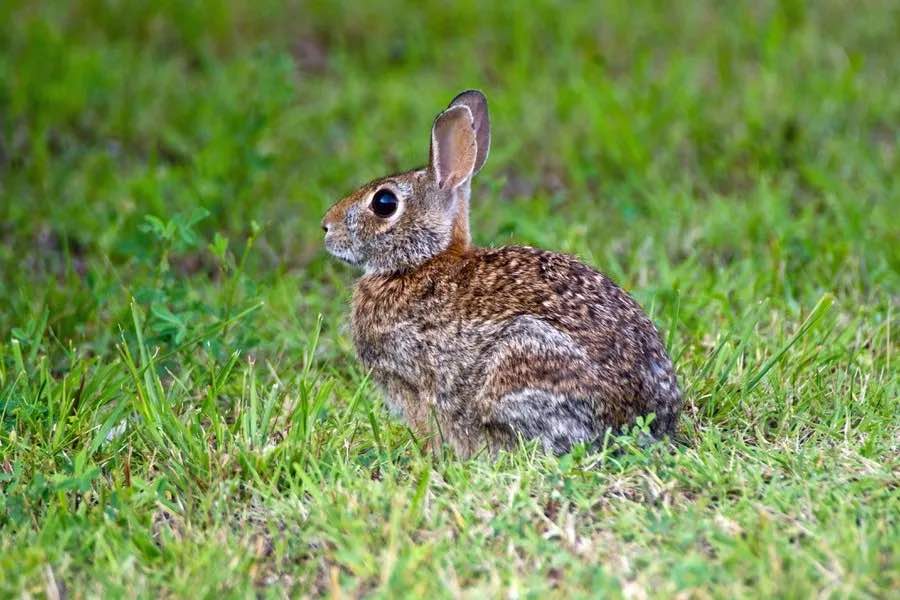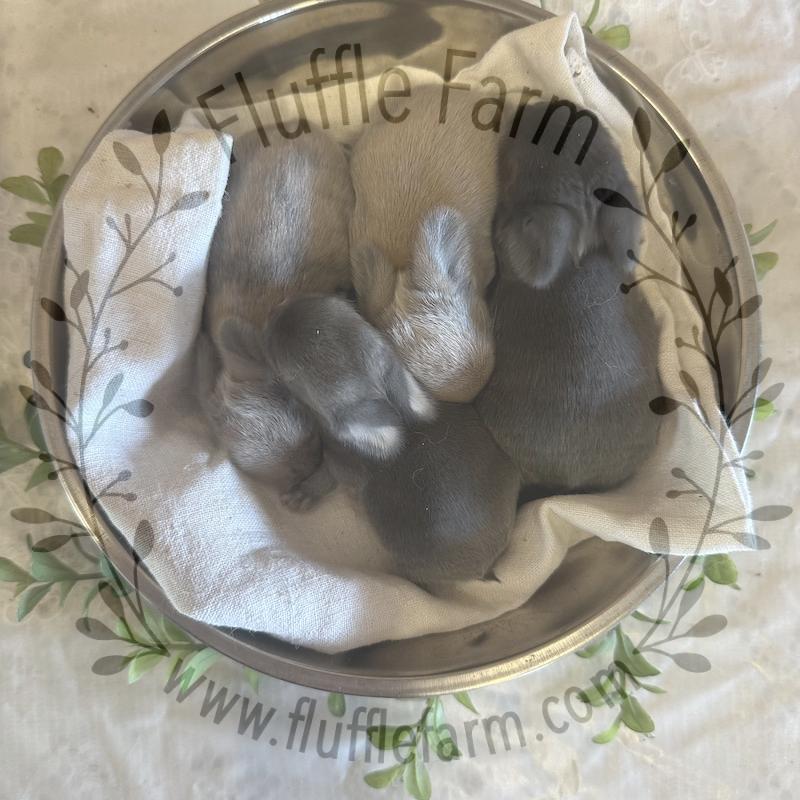
A wild Cottontail Rabbit Image Credit

A definitely not-wild very-spoiled couch-potato floof.

Absolutely not-wild cuddle-puddle fluffle of domesticated floofs.
It is not uncommon for a dog or kid or unsuspecting lawn mower pusher to find a small rabbit outside in the yard. I get calls and messages about what to do with baby bunnies regularly. Especially when we lived in Florida and bunnies bred year round. As much as I and many wildlife rescues would have loved to help, wild bunnies are a whole different world than domesticated bunnies–and it comes with significant risk. So let’s chat about wild buns.
First, How can you tell if it’s a wild bunny or a domestic bunny? Domesticated breeds have a more round headshape, even the pointier-nosed varieties look different than their wild counterparts. The slope from the top of the wild rabbit’s head to their nose is very straight and slender. They will have uniform hair length and are usually reddish brown or grey in color. Their cheeks are slimmer as well as their bodies and they are very very fast. Domestic bunnies have rounder cheeks and eyes, fuller bodies and can have longer hair and floppy ears.
How can you tell if it’s ok to be on its own? Wild bunnies are weaned around 4 weeks old – because mama more than likely is already carrying another litter of babies and will abandon her month old kits to care for the newborns. A general rule of thumb is if the bunny is about the size of a tennis ball – it’s weaned and fine to be on its own.
But I haven’t seen Mama? She abandoned them! Meh, probably not, bunnies only feed 1-2 times a day with super high calorie milk that is nearly impossible to mimic. Because of its unique composition and nutrient density, mama buns can visit the nest quickly and infrequently so they can protect their babies as long as possible to give them the best chance at survival to adulthood. It’s common to think that bunnies will abandon their babies if you touch them. This isn’t entirely true–while it can happen, most of the time the rabbit mama will still come back for her babies if she deems the area safe enough for her to continue to do so.
My dog/cat/wombat found their nest and I don’t know what to do with the baby. I can’t just leave it there, Lassy/Sassy/Wombat-y will find them for sure. Well during the day you can cover the nest with an upside down laundry basket and secure it with a rock, or something kinda heavy so it won’t blow away. Then you do have to keep Lassy/Sassy/Wombat-y away from the area during the day and at dusk you take the basket off and leave access to the babies all night long until after sunrise. Mama will feed the babies at dusk and dawn and leave them alone during the day – for you to cover and keep safe.
Can I just scootch them under a nearby bush and hope for the best? Absolutely. Ultimately you may have NEVER seen those babies if you were a few minutes late to their rescue or if their nest wasn’t in your space. While it is best to leave them where you found them–especially if mama built a nest for them–if that is absolutely not possible, you can scootch them to a nearby place, but know that baby rabbits do not have any scent and do not make any noise–so it can be nearly impossible for the mama to find them after they have moved. It can be hard to remember that rabbits are a prey food meaning they are absolutely some animals next meal. It’s why the daddies are so quick and effective, the mamas are made to reproduce quickly and carry multiple litters at once, and why in the wild most rabbits don’t like past a few years old. It’s also why domesticated rabbits are prone to reproductive cancers. They don’t tend to live long enough for them to develop in the wild.
Can’t I find a wildlife rehabilitation or rescue to bring them to? Surely someone can help this poor baby! Newborn and young rabbits are extremely hard to keep alive. They aspirate easily, they are very small, they have a different shape to their mouth/lips than most of us are used to, they have to be fed more often since we cannot mimic rabbit mama milk in terms of calories and volume so they end up eating more often, their tummies are very sensitive and can be more prone to enteritis… and the list goes on. Even some of the best wildlife rehabbers I know won’t take in baby bunnies — it’s just not worth the hassle and time. Another animal can have the time and care that have a better shot at survival.
Can you help feed them? Do you have a mama that can foster them? While this would seem like an easy thing to do — it’s actually extremely dangerous. Not to say people haven’t done it, but wild bunnies tummies are different than domesticated bunny tummies. Their immune systems are vastly different and diseases and viruses that wild bunnies carry can wipe out an entire rabbitry in a matter of days. RHDV2 is one of the big ones that can wipe out a rabbitry in half a week–you simply wouldn’t have time to react. (See more about RHDV2 in Pennsylvania from PSU’s College of Agricultural Sciences.) For the safety of our bunnies and babies, we can’t even touch them.



